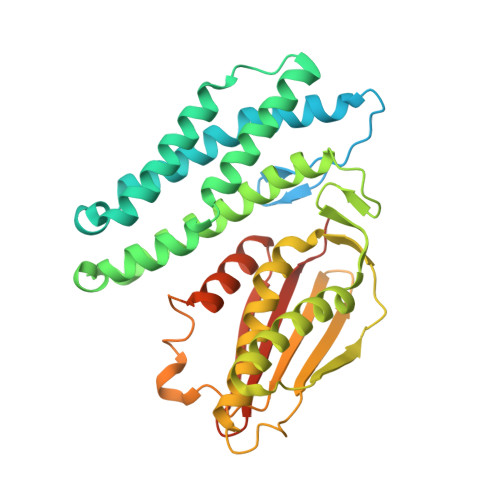Structure-based design and mechanisms of allosteric inhibitors for mitochondrial branched-chain alpha-ketoacid dehydrogenase kinase.
Tso, S.C., Qi, X., Gui, W.J., Chuang, J.L., Morlock, L.K., Wallace, A.L., Ahmed, K., Laxman, S., Campeau, P.M., Lee, B.H., Hutson, S.M., Tu, B.P., Williams, N.S., Tambar, U.K., Wynn, R.M., Chuang, D.T.(2013) Proc Natl Acad Sci U S A 110: 9728-9733
- PubMed: 23716694
- DOI: https://doi.org/10.1073/pnas.1303220110
- Primary Citation of Related Structures:
3TZ0, 3TZ2, 3TZ4, 3TZ5, 4DZY, 4H7Q, 4H81, 4H85 - PubMed Abstract:
The branched-chain amino acids (BCAAs) leucine, isoleucine, and valine are elevated in maple syrup urine disease, heart failure, obesity, and type 2 diabetes. BCAA homeostasis is controlled by the mitochondrial branched-chain α-ketoacid dehydrogenase complex (BCKDC), which is negatively regulated by the specific BCKD kinase (BDK). Here, we used structure-based design to develop a BDK inhibitor, (S)-α-chloro-phenylpropionic acid [(S)-CPP]. Crystal structures of the BDK-(S)-CPP complex show that (S)-CPP binds to a unique allosteric site in the N-terminal domain, triggering helix movements in BDK. These conformational changes are communicated to the lipoyl-binding pocket, which nullifies BDK activity by blocking its binding to the BCKDC core. Administration of (S)-CPP to mice leads to the full activation and dephosphorylation of BCKDC with significant reduction in plasma BCAA concentrations. The results buttress the concept of targeting mitochondrial BDK as a pharmacological approach to mitigate BCAA accumulation in metabolic diseases and heart failure.
- Department of Biochemistry, University of Texas Southwestern Medical Center, Dallas, TX 75390, USA.
Organizational Affiliation:

















